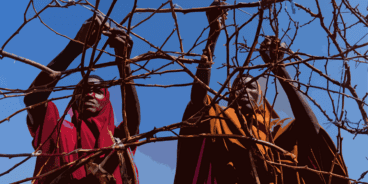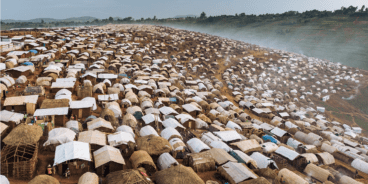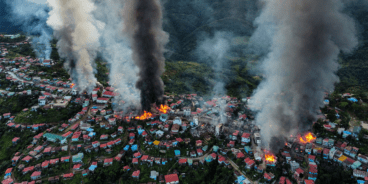
From Global Warming to Genocide Warning: Climate Change and Mass Atrocities
In the winter of 2006 Syria experienced the beginning of the most crippling drought in its recorded history. By 2009 key crops had declined by more than half, plunging almost a million people into food insecurity. In the northeast of the country farmers lost 85% of their livestock as wells dried up and farm animals died. About 10% of the population saw their livelihoods wiped out. During the three-year drought, more than 1.5 million Syrians fled from their farms, migrating to Aleppo, Damascus, Homs and other urban centers.
Rising temperatures and declining rainfall afflicted the entire Fertile Crescent, where agriculture was first born about 11,000 years ago, but fell particularly severely upon Syria. The ruling Assad family didn’t create the drought, but decades of dictatorship and dysfunctional policies around water management and unsustainable agriculture exacerbated its consequences. Facing poverty, hunger and water scarcity, resentments accumulated on the periphery of Syria’s cities and in the countryside. Then came the “Arab Spring.”
The confluence of these events has caused some to draw a causal link between them. In the words of US Secretary of State John Kerry, “It’s not a coincidence that immediately prior to the civil war in Syria, the country experienced its worst drought on record.” Environmental disaster intensified the “political unrest that was just beginning to roil and boil in the region,” adding stress on cities plagued by crumbling infrastructure, social inequality, overcrowding and corruption. In this scenario, climate change helped ignite the most bitter and bloody civil war of our times, providing a disturbing portent of our potential future.
Threat Multiplier
Kerry is not alone in identifying a disturbing credible connection between climate change and deadly conflict. Former UN Secretary-General Kofi Annan argued in his Millennium Report that climate change “may increase social and political tensions in unpredictable and potentially dangerous ways.” In 2014 the US Department of Defense described climate change as a “threat multiplier,” noting that a rise in global temperatures may “intensify the challenges of global instability, hunger, poverty, and conflict,” posing a particular threat to already fractured societies.
These challenges may also increase the possibility of mass atrocity crimes – genocide, war crimes, ethnic cleansing and crimes against humanity. Although the UN’s Framework of Analysis for Atrocity Crimes does not specifically address global warming, there are two risk factors that are directly relevant: motives or incentives, and triggering factors. Triggering factors could include environmental changes that drastically affect entire societies, including severe drought or natural disaster. Motives or incentives could potentially include a dramatic widening of inequality because of climate change, including food and water scarcity, environmental degradation, and the political manipulation of access to precious resources. But does the existing evidence support this grim prognosis?
In 2007 UN Secretary-General Ban Ki-moon linked climate change to the outbreak of deadly conflict in Darfur, arguing that a harsh drought had resulted in armed hostilities between settled farmers and nomadic herders. In 2012 deadly inter-communal clashes between Orma and Pokomo communities in Kenya’s Tana River Delta were perceived as being primarily driven by tribal animosities and political rivalries. However, the two ethnic communities were actually fighting over water access, scarce grazing land and tensions arising from land development.
Fighting between semi-nomadic herders and settled farmers has also occurred in Ethiopia, Central African Republic and elsewhere, sometimes escalating to the level of mass atrocity crimes. For example, in Nigeria rising temperatures and drought have caused Fulani herdsmen to migrate further south than ever before. In doing so, they have clashed with established agricultural communities. The fact that the Fulani herdsmen are mainly Muslim and the communities they are battling are predominately Christian has deepened animosities in a country that is already experiencing deadly conflict. While Boko Haram’s atrocities have attracted international headlines, there have been at least 6500 deaths resulting from violence between the Fulani and other communities in Nigeria since 2010.
Extended dry seasons, caused by climate change, could have a similar effect on ethnic conflict in South Sudan, where traditions of cattle raiding between competing communities of Neur, Murle and Dinka have increased in longevity and violent intensity over the last decade. Meanwhile in Yemen, growing water scarcity has had a direct impact on the conduct of the country’s civil war. Armed forces on both sides have deliberately targeted infrastructure in order to deprive rival civilian populations of access to water, effectively weaponising climate change.
Where governance is weak, the threat posed by climate change looms largest. There are predictions that accelerating climate change could potentially displace between 50 and 250 million people globally. It will also increase global hunger and the regularity of catastrophic environmental events. The resulting pressures may limit the capacity of some governments in the developing world to fulfill their basic functions.
We have already experienced this firsthand in relation to the 2014-2015 Ebola epidemic in West Africa. Understandably, the governments of Liberia, Guinea and Sierra Leone prioritized the health emergency over programs to consolidate the rule of law, dealing with past conflicts, and strengthening human rights institutions. Similar re-prioritization may occur in the face of expanded environmental crises with a long-term impact on political stability and economic development.
In 2010 the Robert S. Strauss Center for International Security and Law released a study of African governments’ institutional resilience to potential challenges presented by climate change. Of the 53 African states studied, the ten most fragile were (in descending order) Cote d’ Ivoire, Guinea-Bissau, Burundi, Zimbabwe, Comoros, Chad, Central African Republic, Sudan, Democratic Republic of the Congo and Somalia. Seven of those have already endured mass atrocities in their recent history, or are experiencing them now. This is the context in which climate change could reignite old conflicts or create conditions for new predatory politics.
2° Temperature Rise = Genocide?
Nevertheless, it is important not to conflate climate change, conflict and the risk of mass atrocities. At least one study has used historical data regarding temperature variation in Africa to argue that “a 1˚ C increase in temperature” leads to “a 4.5% increase in civil war.” But predictive modeling developed from such studies runs the risk of being wildly misleading. There is certainly no evidence that a one or two degree increase in global temperatures will automatically increase the likelihood of genocide in Africa or anywhere else.
I come from a “sunburnt country” and have personally experienced extended drought. But water scarcity in Western Australia has never resulted in civil war or a refugee exodus as it has in Syria. Similarly, no one is trying to bomb Southern California’s depleted water reservoirs like they are in Yemen. And herdsmen are not migrating south from Oregon to kill people and secure access to fertile grazing lands in Silicon Valley.
This should remind us that political history and economic development play an indispensable role in all of this. Indeed, even in areas most vulnerable to climate change and extreme conflict, the results are not universally negative. Water management in the Lake Chad Basin and the threat posed by Boko Haram has actually enhanced cross-border cooperation between Nigeria, Chad, Niger and Cameroon. Climate change undoubtedly threatens the future of our planet, but it might also enhance diplomatic collaboration.
Mass atrocities are the result of a convergence of vulnerabilities, of which climate change is just one. In the future ethnic warlords, authoritarian rulers and aspiring demagogues will undoubtedly use the consequences of climate change to mobilize support. But to quote Vesselin Popovski of United Nations University, “what will drive their fight is not the rain, the temperature, or the sea level.” The primary causes of conflict will remain raw politics and naked economics.
Precisely because climate change is a global problem, it provokes us to think beyond borders. From the Paris Agreement and the UN’s Sustainable Development Goals, to upholding our international responsibility to protect, the solution lies in severing the link between climate and survival for those people and places that are most susceptible to the ruinous effects of climate change. This should give us hope. Mass atrocity crimes are incited, organized and perpetrated by human beings. That means that like climate change, they can still be prevented by human beings.
Related Content


Atrocity Alert No. 305: Special Issue on global displacement and mass atrocities
